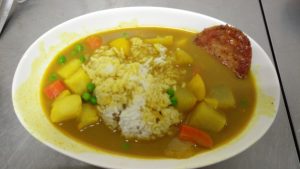
Curry is a generic term primarily employed in Western culture to denote a wide variety of dishes who originate in southern and southeastern Asian countries. A quick overview on major dissemination of curry dishes:
Curries of India
Goa: Curries known as vindaloo have become well known in Great Britain, America, and elsewhere, where the name is usually used simply to indicate a fiery dish of lamb or chicken frequently including potatoes.
Karnataka: The curries of Karnataka are typically vegetarian.They use a wide variety of vegetables and spices and coconut and jaggery are common tastes.
Kerala: They topically contain shredded coconut paste or curry leaves and various spices. Mustard seeds are used in almost every dish, along with onions, curry leaves, sliced red chilies fried in hot oil. Most of the non-vegetarian dishes are heavily spiced.
Tamil Nadu: Traditionally vegetarian foods dominate the menu with a range of non-vegetarian dishes including fish and seafood cooked with spices and seasoning. Major spices include curry leaves, coriander, ginnier, garlic, chili, anise seeds, coconut and so forth.
Maharashtra: They vary from mildly spicy to very spicy and include vegetarian, mutton, chicken and fish. In western Maharashtra, curries are very spicy and groundnut powder is often added to it. The ingredients commonly used are besan, or chickpea flour, and groundnut powder.
Kashmir: In the West, the best-known curry is Rogan josh, a wet curry of lamb with a brilliant red gravy whose color is derived from a combination of Kashmiri chillis and an extract derived from the red flowers of the cockscomb plan.
Gujarat: Although “wet curries" play a smaller role in Gujarat than elsewhere, there are a number of vegetarian examples with gravies based on buttermilk or coconut milk.
Curries of Japan
Japanese curry is one of the most popular dishes in Japan and is usually eaten as karē raisu — curry, rice and often pickled vegetables, served on the same plate. It is less spicy and seasoned than Indian and Southeast Asian curries, being more of thick Japanese stew than a curry. The standard Japanese curry contains onion, carrots, potatoes and sometimes celery. Sometimes grated apple or honey are added for additional sweetness.
Curries of Thailand
In Thai cuisine, curries are called kaeng, and usually consist of meat, fish and/or vegetables in a sauce based on a paste made from chilies, onions or shallots, garlic, and shrimp paste. Local ingredients, such as chili peppers, kaffir lime leaves, lemon grass, galanga and, in central and southern Thai cuisine, also coconut milk are used. Northern and northeastern Thai curries generally do not contain coconut milk. Due to the use of fresh herbs, spices, and other fresh ingredients, Thai curries tend to be more aromatic than Indian curries.
Reference: Indian Cookery Terms, Cookeryonline.com, Wikipedia